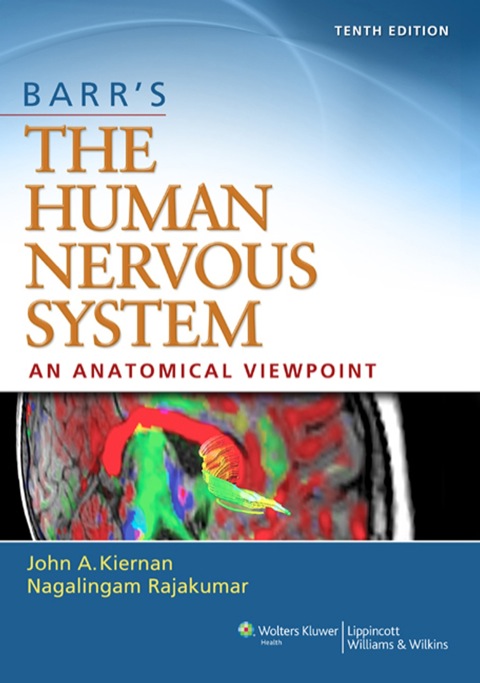Description
Efnisyfirlit
- BARR’S The Human Nervous System: An Anatomical Viewpoint, Tenth Edition
- Copyright
- Preface
- New to the Edition
- Acknowledgments
- Contents
- Part I: Introduction and Neurohistology
- Chapter 1: Development, Composition, and Evolution of the Nervous System
- Important Facts
- Development of the Nervous System
- Development of the Meninges
- Summary of Main Regions of the Central Nervous System
- Size of the Human Brain
- Suggested Reading
- Chapter 2: Cells of the Nervous System
- Important Facts
- Neurons
- Myelin
- Saltatory Conduction in Myelinated Axons
- Conduction Velocity and the Compound Action Potential
- Axonal Transport
- Responses of Neurons to Injury
- Neuroglial Cells
- Suggested Reading
- Chapter 3: Peripheral Nervous System
- Important Facts
- General Organization
- Components of Nerves, Roots, and Ganglia
- Sensory Endings
- Effector Endings
- Ganglia
- Peripheral Nerves
- Suggested Reading
- Chapter 4: Imaging Techniques and Neuroanatomical Research Methods
- Important Facts
- Imaging the Nervous System
- Methods for Investigating Neural Pathways and Functions
- Metabolic Marking Methods
- Physiological and Pharmacological Methods
- Suggested Reading
- Part II: Regional Anatomy of the Central Nervous System
- Chapter 5: Spinal Cord
- Important Facts
- Gross Anatomy of the Spinal Cord and Nerve Roots
- Internal Structure of the Spinal Cord
- Spinal Reflexes
- Suggested Reading
- Chapter 6: Brain Stem: External Anatomy
- Important Facts
- Medulla Oblongata
- Pons
- Fourth Ventricle
- Midbrain
- Suggested Reading
- Chapter 7: Brain Stem: Nuclei and Tracts
- Important Facts
- Medulla
- Dorsal Pons (Tegmentum)
- Ventral or Basal Pons
- Midbrain
- Visceral Pathways in the Brain Stem
- Suggested Reading
- Chapter 8: Cranial Nerves
- Important Facts
- The Ocular Motor System
- Other Cranial Nerves
- Summary of Cranial Nerve Nuclei and Components
- Suggested Reading
- Chapter 9: Reticular Formation
- Important Facts
- Nuclei of the Reticular Formation
- Functions of the Reticular Formation
- Miscellaneous Nuclei of the Brain Stem
- Suggested Reading
- Chapter 10: Cerebellum
- Important Facts
- Gross Anatomy
- Cerebellar Cortex
- Neuronal Organization
- Central Nuclei
- Cerebellar Peduncles
- Functional Anatomy
- Suggested Reading
- Chapter 11: Diencephalon
- Important Facts
- Gross Features
- Thalamus
- Subthalamus
- Epithalamus
- Hypothalamus
- Anterior Pituitary Hormones
- Third Ventricle
- Suggested Reading
- Chapter 12: Corpus Striatum
- Important Facts
- Terminology
- Lentiform and Caudate Nuclei
- Connections
- Physiology and Neurochemistry of the Basal Ganglia
- Suggested Reading
- Chapter 13: Topography of the Cerebral Hemispheres
- Important Facts
- Major Sulci and Fissures
- Lobes of the Cerebral Hemispheres
- Gyri and Sulci
- Medial and Inferior Surfaces
- Limbic Lobe
- Suggested Reading
- Chapter 14: Histology of the Cerebral Cortex
- Important Facts
- Cortical Neurons
- Cortical Layers
- Variations in Cytoarchitecture
- Intracortical Circuits
- Afferent and Efferent Fibers
- Columnar Organization
- Electroencephalography
- Suggested Reading
- Chapter 15: Functional Localization in the Cerebral Cortex
- Important Facts
- Parietal, Occipital, and Temporal Lobes
- Frontal Lobe
- Language Areas
- Hemispheral Dominance
- Suggested Reading
- Chapter 16: Cerebral White Matter and Lateral Ventricles
- Important Facts
- Cerebral White Matter
- Lateral Ventricles
- Suggested Reading
- Chapter 17: Olfactory System
- Important Facts
- Olfactory Epithelium and Olfactory Nerves
- Olfactory Bulb, Tract, and Striae
- Olfactory Areas of the Cerebral Hemisphere
- Terminal and Vomeronasal Nerves
- Suggested Reading
- Chapter 18: Limbic System: The Hippocampus and the Amygdala
- Important Facts
- Hippocampal Formation
- Amygdaloid Body (Amygdala)
- Temporal Lobe Disorders
- Suggested Reading
- Part III: Review of the Major Systems
- Chapter 19: General Sensory Systems
- Important Facts
- Spinothalamic System
- Medial Lemniscus System
- Sensory Pathways for the Head
- Suggested Reading
- Chapter 20: Visual System
- Important Facts
- Retina
- Pathway to the Visual Cortex
- Visual Reflexes
- Other Optic Connections
- Suggested Reading
- Chapter 21: Auditory System
- Important Facts
- External and Middle Ear
- Inner Ear
- Auditory Pathways
- Suggested Reading
- Chapter 22: Vestibular System
- Important Facts
- Static Labyrinth
- Kinetic Labyrinth
- Vestibular Pathways
- Practical Aspects of the Vestibular System
- Suggested Reading
- Chapter 23: Motor Systems
- Important Facts
- Lower Motor Neuron and Muscles
- Descending Pathways to the Spinal Cord
- Descending Pathways to Motor Nuclei of Cranial Nerves
- Systems That Control the Descending Pathways
- Suggested Reading
- Chapter 24: Visceral Innervation
- Important Facts
- Visceral Efferent or Autonomic System
- Central Control of the Autonomic Nervous System
- Visceral Afferents
- Suggested Reading
- Part IV: Blood Supply and the Meninges
- Chapter 25: Blood Supply of the Central Nervous System
- Important Facts
- Arterial Supply of the Brain
- Vasomotor Control
- Venous Drainage of the Brain
- Blood Supply of the Spinal Cord
- Imaging Cerebral Blood Vessels
- Blood–Brain Barrier
- Suggested Reading
- Chapter 26: Meninges and Cerebrospinal Fluid
- Important Facts
- Dura Mater and Associated Structures
- Pia–Arachnoid
- Cerebrospinal Fluid
- Suggested Reading
- Glossary of Neuroanatomical and Related Terms
- Suggested Reading
- Index






Reviews
There are no reviews yet.